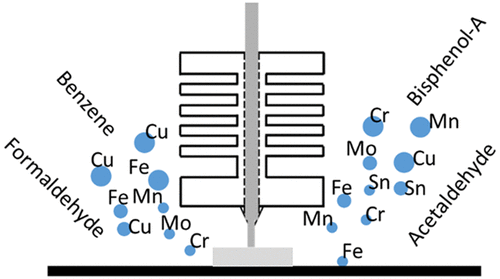当前位置:
X-MOL 学术
›
ACS Chem. Health Saf.
›
论文详情
Our official English website, www.x-mol.net, welcomes your
feedback! (Note: you will need to create a separate account there.)
Use of 3-Dimensional Printers in Educational Settings: The Need for Awareness of the Effects of Printer Temperature and Filament Type on Contaminant Releases
ACS Chemical Health & Safety ( IF 2.9 ) Pub Date : 2021-08-31 , DOI: 10.1021/acs.chas.1c00041 Aleksandr B Stefaniak 1 , Lauren N Bowers 1 , Gabe Cottrell 2 , Ergin Erdem 2 , Alycia K Knepp 1 , Stephen Martin 1 , Jack Pretty 3 , Matthew G Duling 1 , Elizabeth D Arnold 1 , Zachary Wilson 2 , Benjamin Krider 2 , Ryan F LeBouf 1 , M Abbas Virji 1 , Arif Sirinterlikci 2
ACS Chemical Health & Safety ( IF 2.9 ) Pub Date : 2021-08-31 , DOI: 10.1021/acs.chas.1c00041 Aleksandr B Stefaniak 1 , Lauren N Bowers 1 , Gabe Cottrell 2 , Ergin Erdem 2 , Alycia K Knepp 1 , Stephen Martin 1 , Jack Pretty 3 , Matthew G Duling 1 , Elizabeth D Arnold 1 , Zachary Wilson 2 , Benjamin Krider 2 , Ryan F LeBouf 1 , M Abbas Virji 1 , Arif Sirinterlikci 2
Affiliation

|
Material extrusion-type fused filament fabrication (FFF) 3-D printing is a valuable tool for education. During FFF 3-D printing, thermal degradation of the polymer releases small particles and chemicals, many of which are hazardous to human health. In this study, particle and chemical emissions from 10 different filaments made from virgin (never printed) and recycled polymers were used to print the same object at the polymer manufacturer’s recommended nozzle temperature (“normal”) and at a temperature higher than recommended (“hot”) to simulate the real-world scenarios of a person intentionally or unknowingly printing on a machine with a changed setting. Emissions were evaluated in a college teaching laboratory using standard sampling and analytical methods. From mobility sizer measurements, particle number-based emission rates were 81 times higher; the proportion of ultrafine particles (diameter <100 nm) were 4% higher, and median particle sizes were a factor of 2 smaller for hot-temperature prints compared with normal-temperature prints (all p-values <0.05). There was no difference in emission characteristics between recycled and virgin acrylonitrile butadiene styrene and polylactic acid polymer filaments. Reducing contaminant release from FFF 3-D printers in educational settings can be achieved using the hierarchy of controls: (1) elimination/substitution (e.g., training students on principles of prevention-through-design, limiting the use of higher emitting polymer when possible); (2) engineering controls (e.g., using local exhaust ventilation to directly remove contaminants at the printer or isolating the printer from students); (3) administrative controls such as password protecting printer settings and establishing and enforcing adherence to a standard operating procedure based on a proper risk assessment for the setup and use (e.g., limiting the use of temperatures higher than those specified for the filaments used); and (4) maintenance of printers.
中文翻译:

在教育环境中使用 3 维打印机:需要了解打印机温度和耗材类型对污染物释放的影响
材料挤出型熔丝制造 (FFF) 3D 打印是一种有价值的教育工具。在 FFF 3-D 打印过程中,聚合物的热降解会释放小颗粒和化学物质,其中许多对人体健康有害。在这项研究中,使用由原始(从未打印)和回收聚合物制成的 10 种不同长丝的颗粒和化学物质排放物,在聚合物制造商建议的喷嘴温度(“正常”)和高于建议的温度(“ hot”)来模拟一个人有意或无意地在更改设置的机器上进行打印的现实场景。使用标准采样和分析方法在大学教学实验室评估排放量。根据迁移率粒度仪测量,基于颗粒数量的排放率高出 81 倍;与常温打印相比,高温打印的超细颗粒(直径 <100 nm)比例高出 4%,中值粒径小 2 倍(所有p值为 <0.05)。再生丙烯腈丁二烯苯乙烯和聚乳酸聚合物长丝与原生丙烯腈丁二烯苯乙烯和聚乳酸聚合物长丝之间的排放特性没有差异。减少教育环境中 FFF 3-D 打印机的污染物排放可以通过控制层次来实现:(1) 消除/替代(例如,培训学生通过设计预防的原则,尽可能限制使用更高排放聚合物); (2) 工程控制(例如,使用局部排气通风直接清除打印机上的污染物或将打印机与学生隔离); (3) 管理控制,例如保护打印机设置的密码以及基于对设置和使用的适当风险评估建立并强制遵守标准操作程序(例如,限制使用高于所用灯丝指定温度的温度); (4)打印机的维护。
更新日期:2021-08-31
中文翻译:

在教育环境中使用 3 维打印机:需要了解打印机温度和耗材类型对污染物释放的影响
材料挤出型熔丝制造 (FFF) 3D 打印是一种有价值的教育工具。在 FFF 3-D 打印过程中,聚合物的热降解会释放小颗粒和化学物质,其中许多对人体健康有害。在这项研究中,使用由原始(从未打印)和回收聚合物制成的 10 种不同长丝的颗粒和化学物质排放物,在聚合物制造商建议的喷嘴温度(“正常”)和高于建议的温度(“ hot”)来模拟一个人有意或无意地在更改设置的机器上进行打印的现实场景。使用标准采样和分析方法在大学教学实验室评估排放量。根据迁移率粒度仪测量,基于颗粒数量的排放率高出 81 倍;与常温打印相比,高温打印的超细颗粒(直径 <100 nm)比例高出 4%,中值粒径小 2 倍(所有p值为 <0.05)。再生丙烯腈丁二烯苯乙烯和聚乳酸聚合物长丝与原生丙烯腈丁二烯苯乙烯和聚乳酸聚合物长丝之间的排放特性没有差异。减少教育环境中 FFF 3-D 打印机的污染物排放可以通过控制层次来实现:(1) 消除/替代(例如,培训学生通过设计预防的原则,尽可能限制使用更高排放聚合物); (2) 工程控制(例如,使用局部排气通风直接清除打印机上的污染物或将打印机与学生隔离); (3) 管理控制,例如保护打印机设置的密码以及基于对设置和使用的适当风险评估建立并强制遵守标准操作程序(例如,限制使用高于所用灯丝指定温度的温度); (4)打印机的维护。











































 京公网安备 11010802027423号
京公网安备 11010802027423号